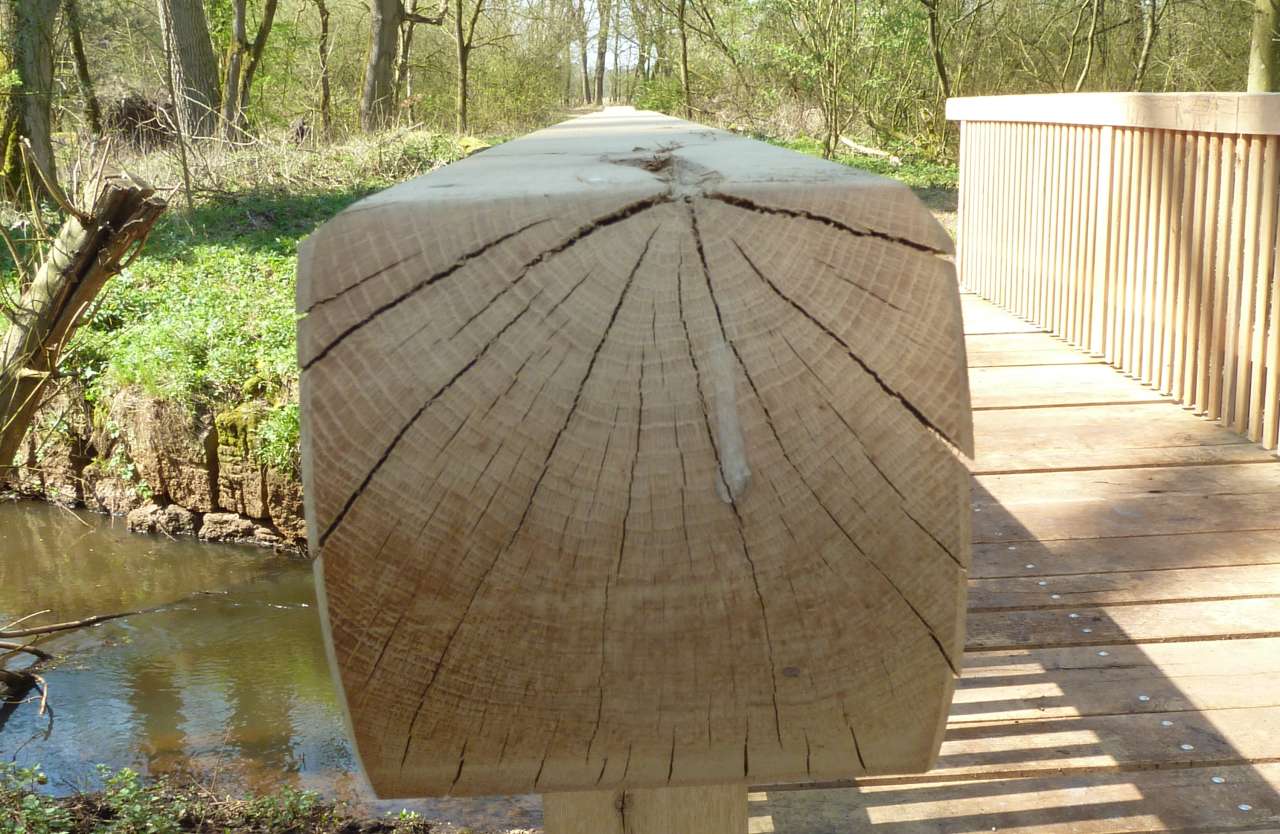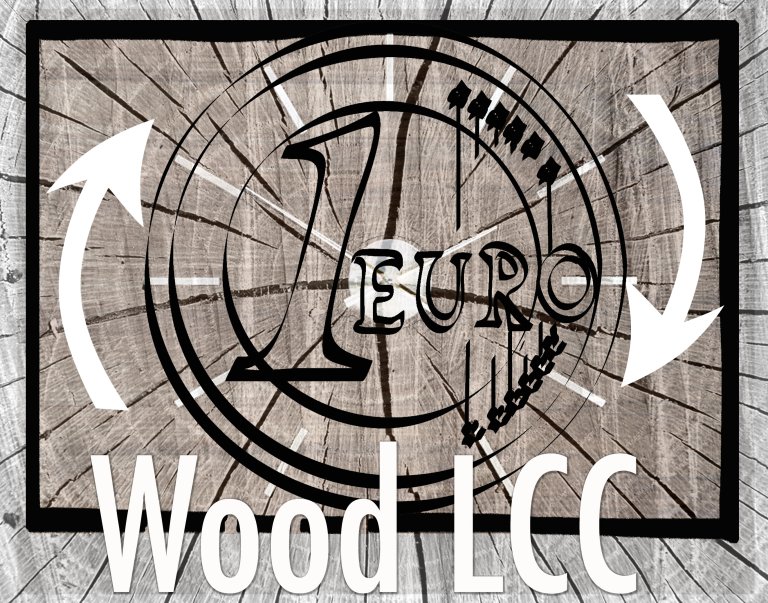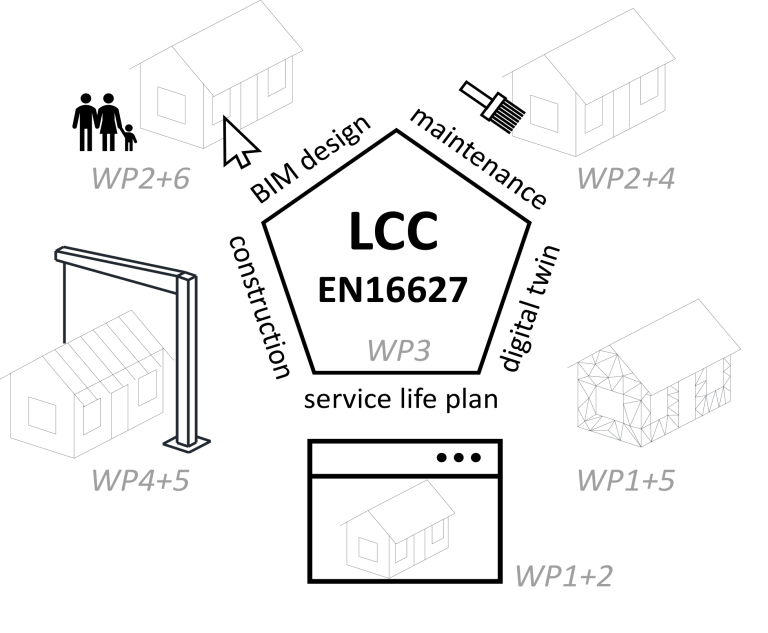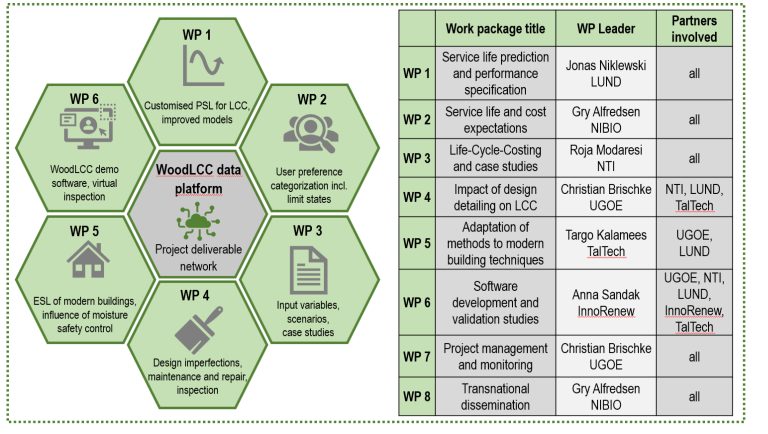Division of Forest and Forest Resources
WoodLCC

End: apr 2025
Start: may 2022
In Enhanced Life-Cycle-Costing in wood construction by novel methods for service life planning (WoodLCC), researches will enable robust and precise Life-Cycle-Costing (LCC) based on input from novel models for detailed service life performance specification for wooden components and buildings.
Project participants
Roja Modaresi / Norwegian Institute of Wood Technology (NTI), Norway Targo Kalamees, Jaan Kers, Villu Kukk / Tallinn University of Technology (TalTech), Estonia Anna Sandak, Jakub Sandak / InnoRenew CoE Renewable Materials and Healthy Environments Research and Innovation Centre of Excellence, Slovenia Jonas Niklewski, Eva Frühwald Hansson / Lund University, Sweden
Industry partners
Miebach (DE)
Sweco Norge AS (NO)
Norconsult Informasjonssystemer – NOIS (NO)
ZRS Architekten (DE)
Holzbau Deutschland (DE)
Swedish Wood (SWE)
Swedish association of wood and furniture industry – TMF (SWE)
Estonian Woodhouse Association (EST)
Estonian Forest and Wood Industries Association (EST)
TreFokus (NO)
Finnlog OÜ (EST)
Lumar IG (SI)

| Start - end date | 01.05.2022 - 30.04.2025 |
| Project manager | Christian Brischke / University of Goettingen, Germany |
| Project manager at Nibio | Gry Alfredsen |
| Division | Division of Forest and Forest Resources |
| Department | Wood Technology |
| Partners | Georg-August-Universität Göttingen/Georg-August-Universität Göttingen Stiftung Öffentlichen Rechts (“UGOE”), Department of Wood Biology and Wood Products, Germany (Coordinator), Norwegian Institute of Wood Technology /Treteknisk (NTI), Norwegian Institute of Bioeconomy Research (NIBIO), Tallinn University of Technology (TalTech), Estonia , InnoRenew CoE Renewable Materials and Healthy Environments Research and Innovation Centre of Excellence, Slovenia, Lund University, Sweden |
| Funding source | ForestValue (for Norway The Research Council of Norway) |
The primary progress beyond the state-of-the-art in WoodLCC is enabling input data for more robust and precise LCC analyses for wooden components and buildings. This will be achieved by the input from novel models for detailed service life prediction data, experimental studies, user preference survey, best practices related to correct design, maintenance action and inspections frequency. The main outcomes from the novel WoodLCC data platform (Figure 5) will contain not only reference service life estimates as direct input to LCC but also realistic maintenance intervals, user preference categorisation incl. the respective limit states, estimated service life of modern building materials, tailor-made risk assessment for moisture and demo plugin for the BIM software. This will result as a pioneer in the timber construction paradigm of Realistic Service Life Scenario (RSLS). This will be achieved by three implementation schemes:
- Evaluation of the reliability of available service life data and research-driven filling of existing gaps (e.g., effect of design imperfections and modern building solutions) by more appropriate reference values
- Customization of previous innovative performance specification models for determination of the estimated service life as well as maintenance scheduling based on user preferences
- Integration of the innovative WoodLCC data platform with a BIM demo software solution combined with other numerical modelling
Main objectives in WoodLCC
- Utilize novel service life prediction models to provide reliable service life estimates for LCC of wooden components and buildings
- Quantify the effect of different maintenance, repair and replacement* schedules on service life and the effect on LCC of buildings
- Survey service life and cost acceptance of stakeholders at a European scale
- Determine LCC of wooden components and buildings in comparison with competing alternatives
- Analyse cost benefits of moisture safety measures during the construction phase
- Quantify the impact of imperfect design details on LCC
- Identify and analyse potential risks related to the use of mass timber in the climate envelope as well as the costs associated with damage and mitigating measures
- Validate service life and LCC estimates based on real-structure inspections
Work Packages in WoodLCC

